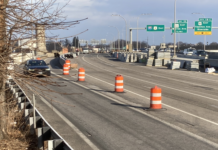
NEW SHOREHAM – Reburial of two 34,500-volt subsea cables on Block Island will involve a potential 10-to-14-day power outage during the first two weeks of April that could lead to island ratepayers footing the bill if there are any delays.
The outage will require the Block Island Power Co. to supply its diesel generated electricity to 2,000 of the island’s ratepayers. The cost for generating electricity using diesel fuel during a 14-day period is about $91,000.
National Grid, who owns the cable that connects the island to the mainland power grid, which is part of the Block Island Wind Farm’s electric transmission system, agreed through a confidential settlement agreement with BIPC to assist in paying for some fuel costs during the first 10 days of the outage. The exact amount was not disclosed due to execution of a confidentiality agreement.
Orsted, the company that owns and operates the wind farm, and the cable that links the wind farm to the island’s power grid, said its repairs will not involve passing along any costs to the state’s ratepayers.
The problem is if the outage extends beyond 10 days, then BIPC and its ratepayers would be required to foot the entire diesel fuel bill for National Grid’s side of the project, from that point forward, to the tune of about $6,500 per day.
Jeffery Wright, president of BIPC, told the Providence Business News that while the reburial project appears on schedule for completion by Memorial Day, May 31, there have been delays involving construction. Block Island can be prone to delays due to the logistics of delivering construction personnel and materials via boat, 13 miles from shore.
“It’s supposed to start the first two weeks of April, but we’re hearing there could be some delays,” said Wright, who noted that the barge containing the new cable sections “has been delayed. From what I understand when the boat left Europe the crew ended up coming down with COVID and had to turn around and go back. So, the submarine cable is delayed in getting here.”
Wright said the cable splicing and accompanied power outage, which had been scheduled for the last two weeks in March, is now scheduled for the first two weeks of April.
As for the fuel cost, Wright said that National Grid had been “refusing to pay for the cost of the fuel.” He added: “We finally came to an agreement, and they gave us some money.”
The negotiation with National Grid was described as “contentious,” he said.
Wright noted that BIPC would cover fuel costs through reserves for costs “above and beyond” what is estimated for the 10-day period. However, if the project goes beyond the allotted 10-day period, then BIPC would be on the hook for footing the bill from that day forward and have to charge a surcharge to its customers.
“We have some reserves built in, so we can cover some costs with our reserves,” said Wright, who was hopeful in not having to charge BIPC’s ratepayers.
National Grid and Orsted did not immediately respond to questions concerning the costs.
National Grid’s history with BIPC regarding ancillary costs related to the Block Island Wind Farm have been contentious, as Wright put it. The utility company has passed along $2.5 million in costs associated with its substation on BIPC property to Block Island ratepayers. Wright said the issue is before the R.I. Supreme Court.
National Grid says construction is on track to complete reburial of the cables at the Town Beach on Block Island prior to the summer season. The two cables became exposed 200 feet from shore due to shifting sands on hard seabed in 2018. The R.I. Coastal Resources Management Council ordered the cables to be reburied by the spring of 2021.
Meaghan Wims, spokeswoman for Orsted, said, “The upgrade is almost complete. The new burial design will keep the cable safe and secure for the remaining life of the project.”
Wims noted that Orsted plans to place the wind farm temporarily offline during a planned outage for several days when a new section of the cable will be spliced with the existing cable. Orsted would not disclose an estimated cable cost.
Ted Kresse, spokesman for National Grid, said, “Construction on the new landfall section of the sea2shore cable, which we’ve estimated to cost approximately $30 million, is making good progress. We have completed the horizontal directional drilling and majority of the land-based civil construction.”
“Over the next several weeks, our cable contractors will be mobilizing to install the new submarine cable, which will be spliced with the existing cable on land and at sea,” said Kresse. “At this time, the project is still on schedule for completion by Memorial Day 2021.”
National Grid has called the project, which began in October of 2020, “complex.” It took National Grid and Orsted about two years to assess, research and design the engineering process for reburial.
The company experienced dense sediment when initially installing its cable in June of 2016 when it landed at the Town Beach. Instead of achieving a burial depth of six feet the cable was buried to an insufficient depth of about two to three feet.
National Grid said the long-term solution has involved drilling under the sand from the Town Beach parking lot to 3,100 feet offshore to create a path for threading its new section of cable. The process allows for the cable to be buried about 30 feet deeper that the original burial path.
Cassius Shuman is a PBN staff writer. Email him at Shuman@PBN.com.












